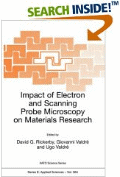|

|
David G. Rickerby, Giovanni Valdrè, Ugo Valdrè, Giovanni Valdre, Ugo Valdre
Impact of Electron and Scanning Probe Microscopy on Materials
This book presents a coherent synopsis of a rapidly evolving field. Subjects covered include diffraction contrast and defect analysis by conventional TEM lattice imaging, phase contrast and resolution limits in high resolution electron microscopy. Specialised electron diffraction techniques are also covered, as is the application of parallel electron energy loss spectroscopy and scanning transmission EM for subnanometer analysis. Materials analyzed include thin films, interfaces and non-conventional materials. WDS and EDS are treated, with an emphasis on phi(rhoZeta) techniques for the analysis of thin layers and surface films. Theoretical and practical aspects of ESEM are discussed in relation to applications in crystal growth, biomaterials and polymers. Recent developments in SPM are also described. A comprehensive survey of the state of the art in electron and SPM, future research directions and prospective applications in materials engineering.
Springer; 2008
|



